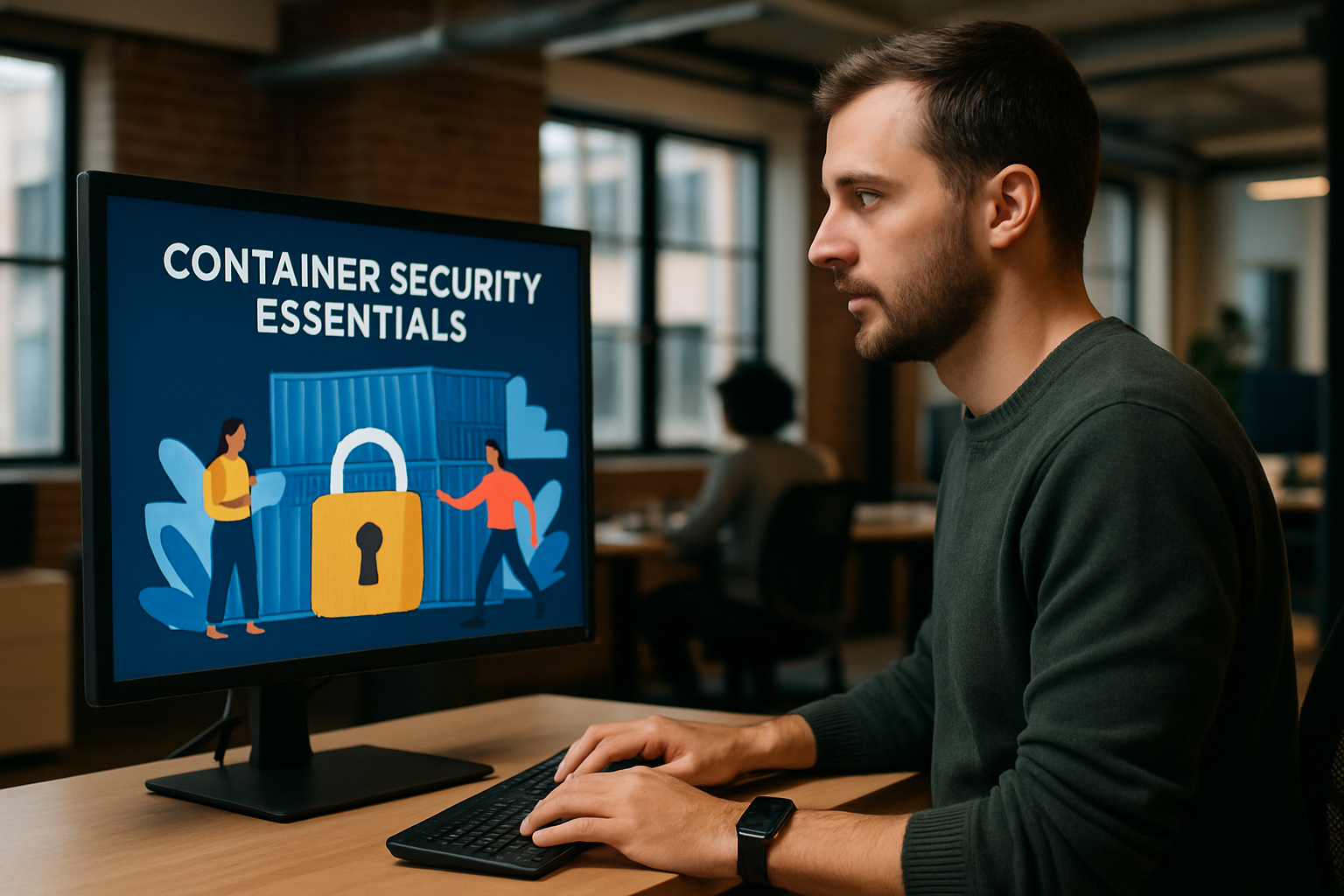
Container security essentials
Containers have transformed the way we develop, deploy, and scale applications. Their lightweight, portable nature accelerates workflows and empowers teams to iterate rapidly. Yet, as with any technological leap, containers introduce new security challenges. Navigating these challenges requires not just technical know-how but a mindset attuned to the nuances of modern infrastructure and the evolving threat landscape.
Understanding Container Fundamentals
Before delving into security, it is essential to ground ourselves in what containers are and how they function. Containers are standardized units of software that package up code and all its dependencies, ensuring consistent execution across environments. Unlike virtual machines, containers share the host operating system’s kernel, making them more efficient but also potentially more vulnerable if not properly isolated.
One of the key strengths of containers—their portability—can also be a double-edged sword if security best practices are not rigorously followed.
This duality underpins the need for a thoughtful, layered approach to container security.
The Shared Responsibility Model
Container security is not the exclusive domain of IT or security teams. Developers, DevOps engineers, operations, and even end-users all play a role. Each stage in the container lifecycle—from building and shipping images to deployment and runtime—presents unique risks and responsibilities.
Shifting security left—embedding security early in the development lifecycle—has become a best practice. This not only reduces vulnerabilities but also fosters a culture where security is seen as an enabler, not a bottleneck.
Common Threats in Containerized Environments
To address container security, we need to recognize the most common threats:
- Insecure Images: Pulling images from untrusted sources can introduce malware or outdated libraries.
- Privilege Escalation: Containers running with root privileges can be leveraged to attack the host system.
- Misconfigured Access Controls: Poorly defined roles and permissions can allow unauthorized access.
- Vulnerable Dependencies: Including outdated or vulnerable dependencies in images increases risk.
- Secrets Management: Hardcoding credentials or secrets in container images or environment variables can expose sensitive data.
- Network Attacks: Unrestricted communication between containers or with external networks can lead to data leaks or lateral movement.
Building Secure Container Images
The journey towards secure containers begins at the image level. Images are the foundation for every container instance, and any vulnerability baked into an image propagates wherever it runs.
Best Practices for Image Security
- Use Official Base Images: Start with well-maintained images from trusted registries like Docker Hub or your organization’s internal registry.
- Minimize Image Size: Smaller images reduce the attack surface. Use minimal base images such as
alpinewhere feasible. - Scan Images Regularly: Integrate automated image scanning tools (e.g., Trivy, Clair, or Anchore) into your CI/CD pipelines to detect vulnerabilities early.
- Pin Image Versions: Specify exact versions or digests in your Dockerfiles to avoid unexpected updates that could introduce vulnerabilities.
- Remove Unnecessary Packages: Only include what is necessary for your application to run. Extraneous packages can harbor vulnerabilities.
- Don’t Run as Root: Specify a non-root user in your Dockerfile using the
USERdirective.
Example: In your Dockerfile, adding
USER appuserafter creating a dedicated user can block many privilege escalation attacks.
Securing the Container Runtime
Even a perfectly built image can be compromised if the container runtime environment is not properly secured. The runtime encompasses everything from the container engine (like Docker or containerd) to the host operating system.
Host Hardening
The host OS is the last barrier between a compromised container and your infrastructure. A hardened host limits the impact of a breach.
- Use Minimal Host OS: Employ lightweight, dedicated operating systems designed for containers, such as
Container-Optimized OSorBottlerocket. - Apply Security Updates Promptly: Regularly patch the host OS and the container engine to mitigate known vulnerabilities.
- Enforce Principle of Least Privilege: Limit user and process privileges on the host.
- Enable Mandatory Access Controls: Implement Linux security modules like SELinux, AppArmor, or seccomp to confine container activity.
Isolation Mechanisms such as namespaces and cgroups are core to container security, providing process and resource separation. However, they are not foolproof—misconfiguration or kernel vulnerabilities can weaken their effectiveness.
Network Security in Containerized Environments
By default, containers on the same host can often communicate freely. This lateral movement can be exploited by attackers. Network segmentation, firewalls, and service meshes can help restrict communication to only what is necessary.
- Define Network Policies: Use Kubernetes network policies or Docker’s built-in network controls to restrict traffic between pods or containers.
- Encrypt Traffic: Employ TLS for all internal and external communication, especially for sensitive data.
- Monitor Network Activity: Tools like Cilium and Calico provide visibility and enforcement of network flows.
“You can’t protect what you can’t see.” Continuous monitoring of network activity is essential for detecting and responding to suspicious behavior.
Managing Secrets and Sensitive Data
One of the most common—and dangerous—mistakes is embedding secrets directly in container images or environment variables. Secrets include API keys, passwords, certificates, and tokens.
Best Practices:
- Use Secret Management Tools: Integrate solutions like HashiCorp Vault, AWS Secrets Manager, or Kubernetes Secrets for secure storage and access.
- Never Store Secrets in Images: Avoid hardcoding secrets in your Dockerfiles or application code.
- Restrict Access: Grant the fewest privileges necessary for your containers to retrieve secrets.
- Rotate Secrets Regularly: Update credentials and tokens at regular intervals to limit exposure if compromised.
Tip: Use Kubernetes’
ServiceAccountand RBAC to tightly control which pods can access specific secrets.
Continuous Monitoring and Incident Response
Security is never a “set and forget” exercise. Attackers are always innovating, and new vulnerabilities emerge daily. Continuous monitoring, threat detection, and incident response are core to resilient container environments.
- Deploy Runtime Security Tools: Solutions like Falco, Sysdig, or Aqua Security can detect anomalous behavior within running containers.
- Aggregate and Analyze Logs: Centralize logs from containers, orchestrators, and hosts for correlation and forensic analysis.
- Establish Alerting and Response Procedures: Define clear escalation paths and automate remediation where possible.
- Regularly Test Incident Response: Conduct tabletop exercises and chaos engineering drills to build confidence and uncover gaps.
Visibility and response readiness are as critical as preventive controls.
Container Orchestration Security: Focus on Kubernetes
For most organizations, containers do not exist in isolation—they are orchestrated by platforms like Kubernetes. Kubernetes brings its own powerful abstractions and, with them, unique security challenges.
Key Areas to Secure in Kubernetes
- Cluster Access: Lock down API access using authentication, authorization (RBAC), and audit logging.
- Pod Security: Enforce PodSecurityPolicies (deprecated, but still in use) or use alternatives like OPA Gatekeeper to restrict capabilities, enforce non-root containers, and disallow privileged mode.
- Resource Quotas and Limits: Set CPU and memory limits to prevent resource exhaustion attacks.
- Network Segmentation: Implement Kubernetes network policies to isolate workloads.
- Secrets Management: Prefer external secret stores and ensure secrets are not mounted as plain text files.
- Supply Chain Security: Use tools like SLSA (Supply-chain Levels for Software Artifacts) and sigstore to verify the provenance and integrity of images and manifests.
Kubernetes is powerful, but with great power comes great responsibility. The flexibility to configure almost anything means the potential for misconfiguration is equally vast.
Automating Security in CI/CD Pipelines
Automation is the linchpin of effective container security. Manual checks are error-prone and cannot scale with modern development velocity. Embedding security into continuous integration and deployment pipelines ensures vulnerabilities are caught early and consistently.
Actionable Steps:
- Integrate Image Scanning: Automatically scan images for known vulnerabilities at build time and before deployment.
- Enforce Linting and Best Practices: Use tools like
dockerlintorhadolintto enforce secure Dockerfile patterns. - Automate Policy Enforcement: Use policy-as-code tools (e.g., Open Policy Agent) to ensure compliance with security standards.
- Continuous Testing: Integrate security tests alongside functional and performance tests in your pipeline.
Security gates should be viewed as quality gates—integral to delivering robust, trustworthy applications.
Fostering a Security-First Culture
Technology alone is not enough. The most secure organizations are those where every team member—regardless of title—feels empowered and responsible for security. Building this culture requires:
- Regular Training: Educate teams on the latest threats, secure coding, and container security practices.
- Open Communication: Encourage sharing of security concerns and foster a blameless post-mortem culture.
- Championing Diversity: Diverse teams bring varied perspectives and can spot risks others might overlook. This is especially important in fast-evolving fields like technology and security.
Women and neurodivergent professionals in technology often bring unique insights to security challenges. Their voices and experiences are vital to holistic, resilient solutions.
Practical Tips for Getting Started
- Start small: Secure one application or environment and build on those successes.
- Automate: Let machines handle the repetitive work of scanning, monitoring, and enforcing policies.
- Document everything: Clear, accessible documentation helps teams stay aligned and onboard new members smoothly.
- Measure progress: Track metrics like time to patch, number of high-severity findings, and incident response time.
- Stay curious: The landscape evolves quickly. Commit to continuous learning and improvement.
Security is a journey, not a destination. Every improvement, no matter how small, strengthens your organization’s resilience.
By thoughtfully combining technical controls with a culture of shared responsibility and learning, organizations can harness the transformative power of containers—securely and confidently. The future of technology is containerized, and with the right approach, it can also be safe for everyone.


